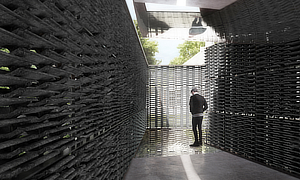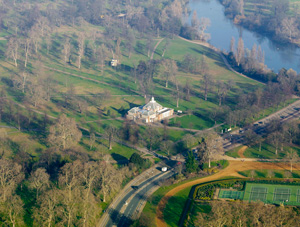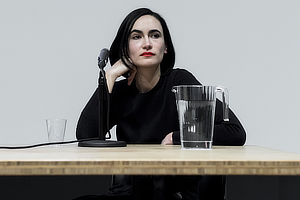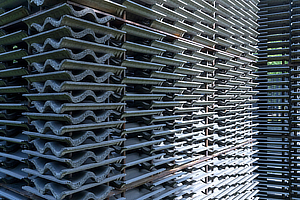 |
 |
 |
 |
 |
 |
| |
 |
|
 |
 |
 |
  |
  |
 |
 |
 |
 |
|
|
 |
|
 |
 |
 |
OPERA |
 |
|
 |
|
 |
 |
 |
| |
 |
| 
 |
Serpentine Gallery Pavilion
Padiglione della Serpentine Gallery |
|
 |
 |
 |
 |
PROGETTISTA |
 |
|
|
 |
|
 |
 |
 |
| |
 |
|
 |
 |
 |
 |
CONTESTO |
 |
|
|
 |
|
 |
 |
 |
| Rapporto con il luogo |
 |
|
 |
|
 |
 |
 |
 |
 |
 |
 |
DESCRIZIONE |
 |
|
|
 |
|
 |
 |
 |
| . |
 |
|
 |
 Frida Escobedo. an architect celebrated for dynamic projects that reactivate urban space. has designed the Serpentine Pavilion 2018. Harnessing a subtle interplay Of light, water and geometry, her atmospheric courtyard design draws on both the domestic architecture of Mexico and British materials and history, specifically the Prime Meridian line at London's Royal Observatory in Greenwich.
Escobedo (b. 1979, Mexico City) is the 18th and youngest architect yet to accept the invitation to design a temporary Pavilion on the Serpentine Gallery lawn in Kensington Gardens. This pioneering commission, which began in 2000 with Zaha Hadid. has presented the first UK structures of some of the biggest names in international architecture. In recent years, it has grown into a hotly anticipated showcase for emerging talent, from Sou Fujimoto of Japan to selgascano of Spain and Bjarke Ingels Of Denmark. whose 2016 Pavilion was the most visited architectural and design exhibition in the world. Serpentine Galleries Artistic Director Hans Ulrich Obrist and CEO Yana Peel selected this year's architect. with advisors David Adjaye and Richard Rogers. The Serpentine Pavilion 2018 is sponsored by Goldman Sachs in its fourth year of support.

Escobedo's Pavilion takes the form Of an enclosed courtyard, comprised of two rectangular volumes positioned at an angle. While the outer walls are aligned with the Serpentine Gallerys eastern faqade, the axis of the internal courtyard aligns directly to the north. Internal courtyards are a common feature of Mexican domestic architecture, while the Pavilion's pivoted axis refers to the prime Meridian, which was established in 1851 at Greenwich and later became the global standard marker of time and geographical distance.
The Serpentine pavilion will once again be a platform for park Nights, the Serpentine's annual series of experimental, interdisciplinary commissions on selected Friday evenings. Supported by COS for a sixth year, Park Nights will present eight international artists each responding to Escobedo's design and offering unique ways of experiencing architecture and live performance.
The Architecture Family pack and Programme, also supported by COS, will give children and their families the chance to explore the Pavilion from playful and original perspectives. The Family Pack is designed by OOMK, a London- based art publishing collective. School groups are invited to join The Summer Studio, a senes of movement based workshops with artist and dancer Zinzi Minott exploring connections between her artistic practice and the Pavilion.
Building on its 2017 success, Radical Kitchen returns on selected Thursday lunchtimes, supported by Aesop and in collaboration with Nicoletta Fiorucci. Artist, activists and researchers will gather with the public to consider different foodstuffs and elements, and their relationship to time, empire and landscape, themes inspired by the ideas behind Frida Escobedo's design. |
|
 |
 |
 |
|
 |
|
| . |
 |
|
 |
|
 |
 |
 |
|
 |
|
| Serpentine Pavilion History |
 |
|
 |
The annual Serpentine Pavilion Commission has become a global platform for architectural experimentation, presenting projects by some of the world's greatest architects, from Zaha Hadid in 2000 to Francis Kéré in 2017. The brief is to design a temporary Pavilion that is used as a community hub and café by day and a forum for learning, debate and entertainment at night. Each Pavilion is sited on the Serpentine Gallery's lawn for four months and the immediacy of the commission has made it a pioneering model worldwide.
 Serpentine Pavilion architects to date are: Serpentine Pavilion architects to date are:
|
|
 |
 |
 |
 |
 |
 |
 |
PUNTI DI VISTA |
 |
|
|
 |
|
 |
 |
 |
| |
 |
 “My design for the Serpentine Pavilion 2018 is a meeting of material and historical inspirations inseparable from the city of London itself and an idea which has been central to our practice from the beginning: the expression of time in architecture through inventive use of everyday materials and simple forms. For the Serpentine Pavilion, we have added the materials of light and shadow, reflection and refraction, turning the building into a timepiece that charts the passage of the day.” __________
The enclosed design for the 2018 Serpentine Pavilion departs from an apparently simple gesture, the nesting of two rectangular volumes positioned at an angle While the outer walls are aligned in parallel to the Serpentine Gallerys eastern facade. the axis of the internal courtyard is aligned directly to the north. The creation of an Internal courtyard is a common feature of Mexican domestic architecture, and the pivoted axis refers to the Prime Meridian established in 1851 at the Royal Observatory in nearby Greenwich, the global standard marker of time and geographical distance. The intersecting planes produced by this simple rotation produce a series of irregular shapes and defined boundaries, with each area within the Pavilion encouraging play, circulation, contemplation and conversation.
The lattice walls of the Pavilion are inspired by a celosia, a traditional breeze wall commonly used in Mexican domestic architecture to bring air and light into the home. Here they are composed of cement roof tiles commonly used in the United Kingdom. arranged into a pattern that diffuses the visitor's view, transforming Kensington Gardens into a blur of greens and blues. The selection of materials, which have a dark colour and textured surface have been chosen for their contrast with these environs.
Two reflective elements inside the Pavilion emphasise the movement of light and shadow within the Pavilion over the course of the day. The curved underside of the canopy over the central space is clad with mirrored panels throwing reflected light across the space. To compliment the canopy, a triangular mirror pool cast into the foundation of the Pavilion traces its boundary directly beneath the edge of the roof, along the north axis. This thin veneer of water, only 5mm deep, provides a shifting reflection of the sky and surrounding treeline and roof of the Serpentine Gallery.
The movement of the sun across the sky, effected and refracted by the pool and mirrored ceiling encourages an awareness of time spent in shared experience and in contemplation. The design aligns material and historical inspirations from Mexico and the UK with a concept that has been central to our practice from the beginning — the expression Of time in architecture through inventive use of everyday materials and simple forms. For the Serpentine Pavilion, we add the materials of light and shadow, reflection and refraction, turning the building into a timepiece that charts the passage of the day. |
|
 |
 |
 |
 |
VIDEO |
 |
|
|
 |
|
 |
 |
 |
| |
 |
|
 |
 |
 |
 |
MATERIALI |
 |
|
|
 |
|
 |
 |
 |
 |
 |
cemento, vetro, acqua British-made materials will be used in the Pavilion’s construction, chosen for their dark colours and textured surfaces. A celosia – a traditional breeze wall common to Mexican architecture – will here be composed of a lattice of cement roof tiles that diffuse the view out into the park, transforming it into a vibrant blur of greens and blues. Two reflecting elements will emphasise the movement of light and shadow inside the Pavilion over the course of the day. The curved underside of the canopy will be clad with mirrored panels, and a triangular pool cast into the Pavilion floor will trace its boundary directly beneath the edge of the roof, along the north axis of the Meridian. As the sun moves across the sky, reflected and refracted by these features, visitors may feel a heightened awareness of time spent in play, improvisation and contemplation over the summer months. _____________
The Pavilion roof consists of a spanning steel structure supported by steel Vierendeel frames. These frames are infilled with wall modules formed of concrete roof tiles arranged in a stretcher bond pattern.
The roof is clad externally, to the flat top surface, with steel plate. covered with a waterproof membrane and internally, to the curved underside. with mirror finish stainless steel panels.
The perimeter boundary of the Pavilion is demarcated with a series of freestanding walls that are completely detached from the roof The walls are constructed in 13m wide by 1.1m high modules stacked three-tall. Each module is formed of concrete roof tiles arranged in a stretcher bond pattern and held in place by a steel frame that cantilevers from the base.
This frame is formed of steel plates top and bottom and a double row of steel bars, arranged at close centres to align with pre-fired holes in the tiles. The walls are generally arranged in north-south and east- west directions, with additional walls, angled on plan defining the main entrances.
The Pavilion sits on a platform of poured reinforced concrete that provides a raft foundation to the structure, The concrete surface is power-floated to provide the floor finish.
The foundation includes a small step-down to a trapezoidal area of the south-west corner of the Pavilion to incorporate a mirror pool. This thin film of water sits over an architecturally integrated closed drainage system to allow the area to function as a reflective water feature or drained for additional floor area.
A sustainable drainage system has again been incorporated below the footprint to capture rainwater guided down from the Pavilion roof through rainwater pipes seamlessly integrated into the supporting walls. The recycled attenuation crates sit below the slab to store and slowly release rainwater into the park's existing soakaway.
|
|
 |
 |
 |
 |
LOCALIZZAZIONE |
 |
|
|
 |
|
 |
 |
 |

|
 |

|

|
 |

|
|
|
 |
|
Sito web |
|
 |
|
 |
 |
 |
 |
MAPPA |
 |
|
|
 |
|
 |
 |
 |
| |
 |
|
 |
 |
 |
 |
|
TIPOLOGIA |
 |
|
|
 |
|
 |
 |
 |
|
|
 |
ARCHITETTURA | Edifici commerciali
Bar, caffetterie
Arredo urbano e strutture per spazi pubblici
Strutture per spazi pubblici
Altre strutture architettoniche
Padiglioni, chioschi, servizi
| |
 |
 |
 |
 |
CRONOLOGIA |
 |
|
|
 |
|
 |
 |
 |
Progetto |
 |
|
 |
| 
 |
2018 - 2018
|
|
Realizzazione |
 |
|
 |
| 
 |
2018 - 2018 |
|
 |
 |
 |
 |
RIFERIMENTI BIBLIOGRAFICI |
 |
|
|
 |
|
 |
 |
 |
|
 |
| Miriam Sitz, "Frida Escobedo to design 2018 Serpentine Pavilion", Architectural Record 3/2018, march 2018, p. 27 |
|
|
| "It's a breeze", Building 9008, 16 february 2018, p. 12 |
|
 |
 |
 |
 |
 |
 |
 |
COMMITTENTE |
 |
|
|
 |
|
 |
 |
 |
| |
 |
|
 |
 |
 |
 |
DATI
DIMENSIONALI |
 |
|
|
 |
|
 |
 |
 |
| Superficie |
 |
|
 |
Overall site area
Gross internal area
- sq.m. 233.3 (including pool area)
- sq.m. 194 (excluding pool area)
Footprint
|
|
| Dimensioni |
 |
|
 |
The footprint of the Pavilion is rectangular on plan, parallel and perpendicular to the east façade of the Serpentine Gallery. A trapezoidal-shaped roof predominantly encloses the eastern half of the pavilion, leaving areas to the north and west open to the elements.
- m. 17.0: Longitudinal dimension of Pavilion roof (in the perpendicular axis to the Gallery)
- m. 9.5: Widwest dimension of the Pavilion roof
- m. 3.21: Maximum height of the Pavilion
|
|
| Altezza |
 |
|
 |
- m. 3.24: Max overall height
- m. 3.24: Max internal ceiling height
- m. 2.6: Min internal ceiling height
|
|
 |
 |
 |
 |
STAFF |
 |
|
|
 |
|
 |
 |
 |
Progetto  |
 |
| Frida Escobedo, Taller de Arquitectura |
|
|
 |
|
|
 |
|
Responsabili del progetto |
 |
|
Gruppo di progettazione |
 |
José Maria Gómez de Leon, Federica Lombardi. Andrés Harvey, Héctor Arce, Carlos Hernández, Mario González, Elisa Herrera
|
|
Direzione artistica |
 |
Hans Ulrich Olbrist
Yana Peel
|
|
Direzione progetto |
 |
| Julie Burnell (Head of Construction and Building Serpentine Galleries) |
|
Ingegneria |
 |
AECOM
Jon Leach,Amy Koerbel, Michael Orr, Madalina Aghinitei, Katja Leszczynska, Jack Wilshaw, Sam Saunders, Carlos Lopes, Ulrich Groenewald, Javier Fanals
|
|
Pianificazione e organizzazione |
 |
DP9
Barnaby Collins, Georgina Redpath
|
|
 |
 |
 |
 |
ANNOTAZIONI |
 |
|
|
 |
|
 |
 |
 |
| |
 |
|
 |
 |
 |
 |
CREDITS |
 |
|
|
 |
|
 |
 |
 |
| |
 |
Photo © Iwan Baan | Serpentine Gallery | Columbia GSAPP [Creative Commons - Attribution 2.0 Generic (CC BY 2.0) license]
Images by Atmósfera © Frida Escobedo, Taller de Arquitectura
Text edited by Serpentine Gallery
Courtesy of Frida Escobedo, Taller de Arquitectura | Serpentine Gallery
|
|
 |
  |
 |
|
|